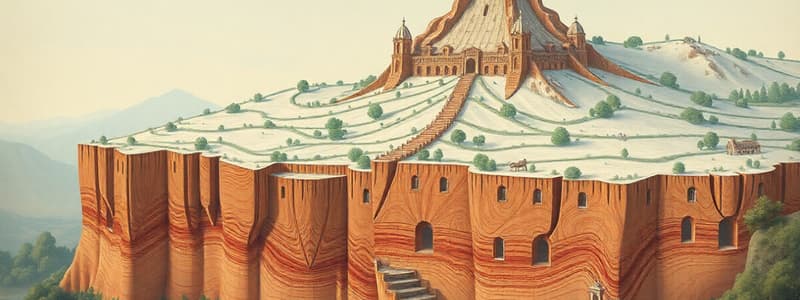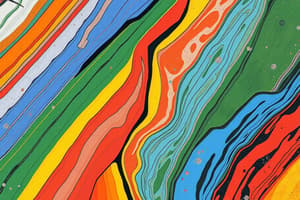Podcast
Questions and Answers
Which type of fault is most commonly associated with divergent plate boundaries?
Which type of fault is most commonly associated with divergent plate boundaries?
- Reverse fault
- Transform fault
- Strike-slip fault
- Normal fault (correct)
What type of stress results in the formation of a reverse fault??
What type of stress results in the formation of a reverse fault??
- Compressional stress (correct)
- Tensional stress
- Hydrostatic stress
- Shear stress
Strike-slip faults are characteristic of which type of plate boundary?
Strike-slip faults are characteristic of which type of plate boundary?
- Subduction zone
- Transform boundary (correct)
- Divergent boundary
- Convergent boundary
At what type of plate boundary would you expect to find a normal fault where the hanging wall has moved downward relative to the footwall?
At what type of plate boundary would you expect to find a normal fault where the hanging wall has moved downward relative to the footwall?
Which of the following plate boundary and fault type combinations creates mountains?
Which of the following plate boundary and fault type combinations creates mountains?
If you observe a fault where the rocks on either side have moved horizontally past each other, which type of fault is it?
If you observe a fault where the rocks on either side have moved horizontally past each other, which type of fault is it?
Which fault type is most likely to result in the shortening and thickening of Earth's crust?
Which fault type is most likely to result in the shortening and thickening of Earth's crust?
What is the primary force causing the displacement of rock along a normal fault?
What is the primary force causing the displacement of rock along a normal fault?
In a region experiencing tensional forces, what type of fault is most likely to develop?
In a region experiencing tensional forces, what type of fault is most likely to develop?
What geologic feature is commonly formed at strike-slip faults?
What geologic feature is commonly formed at strike-slip faults?
Which type of fault is characterized by the hanging wall moving upward relative to the footwall?
Which type of fault is characterized by the hanging wall moving upward relative to the footwall?
Along which type of plate boundary are strike-slip faults most commonly found?
Along which type of plate boundary are strike-slip faults most commonly found?
What type of stress regime is associated with the formation of normal faults?
What type of stress regime is associated with the formation of normal faults?
In a convergent plate boundary setting, what type of fault is most likely to occur as one plate is forced beneath another?
In a convergent plate boundary setting, what type of fault is most likely to occur as one plate is forced beneath another?
At what type of boundary do the plates slide past each other, often causing strike-slip faults?
At what type of boundary do the plates slide past each other, often causing strike-slip faults?
What kind of fault would you expect to see in a region where the crust is being stretched?
What kind of fault would you expect to see in a region where the crust is being stretched?
Which type of fault is least likely to directly cause the formation of a subduction zone?
Which type of fault is least likely to directly cause the formation of a subduction zone?
What type of fault is created by compressional forces?
What type of fault is created by compressional forces?
Where are you most likely to find plates sliding past each other, generating strike-slip faults?
Where are you most likely to find plates sliding past each other, generating strike-slip faults?
Mountains commonly form at convergent boundaries. What kind of faulting contributes to this process?
Mountains commonly form at convergent boundaries. What kind of faulting contributes to this process?
Flashcards
Normal Fault
Normal Fault
Rock moves down due to the tension from divergent boundaries.
Reverse Fault
Reverse Fault
Rock moves upward due to squeezing and compressional forces from convergent boundaries.
Strike-Slip Fault
Strike-Slip Fault
Rocks slide past each other in opposite directions, typically caused by transform boundaries.
Divergent boundary
Divergent boundary
Signup and view all the flashcards
Convergent Boundary
Convergent Boundary
Signup and view all the flashcards
Transform Boundary
Transform Boundary
Signup and view all the flashcards
Study Notes
- Normal faults occur when rock moves down.
- These are associated with divergent boundaries.
- Reverse faults occur when rock moves upward.
- These are associated with convergent boundaries.
- Strike-slip faults occur when rocks slide past one another in opposite directions.
- These are associated with transform boundaries.
Studying That Suits You
Use AI to generate personalized quizzes and flashcards to suit your learning preferences.




